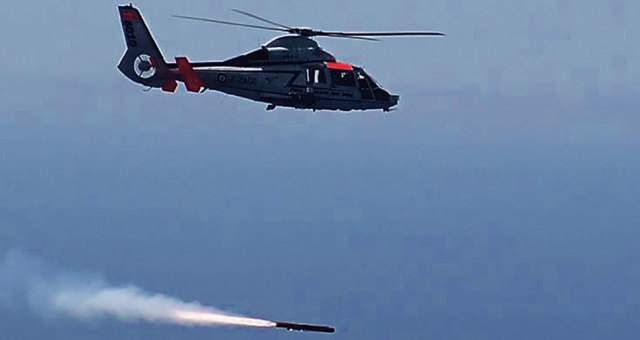french and british fleets to receive new anti-ship missile
The Franco-British company MBDA announced the completion of test tests of anti-ship missiles Sea Venom/ANL. Their culmination was a shooting conducted by the DGA (General Directorate of Armaments of France), during which the missile's ability to find a real target was tested in the presence of a large number of friendly and neutral vessels in the area of attack.
The new missiles will be armed with Panther and NH90 helicopters in the French Navy and AW159 Wildcat helicopters in the Royal Navy. MBDA claims that due to the common characteristics with its predecessors, Sea Venom will be able to easily integrate on platforms that already have Sea Skua and AS15 TT. The Sea Venom/ ANL missile will also be armed with French-made H160M Guepard ship helicopters, which will soon enter service with the US Marine Corps.
The tests included an expanded ability of the missile to find the correct target and aim at it in a complex jamming and target environment in a mode repeated when there are many ships around the enemy ship, including civilian and allied ones. During the tests, the missile launch ranges and ceilings were checked, as well as its operating modes: flight at ultra-low altitude (1.5 m), target capture after launch (LOAL), automatic locking before launch (LOBL), semi-automatic guidance by the operator and changing the flight task in flight (changing the target).
MBDA President Eric Beranger thanked the British and French teams for the commitment they showed in the missile qualification process during the failures caused by COVID-19: "We have proven that by working together, we can overcome adversity and provide the armed forces with the most advanced combat capabilities."
Sea Venom/ANL is the result of a collaboration created through the Lancaster House Defence Treaty concluded between France and the United Kingdom. This is the first program that fully uses the design capabilities of the centers of advanced technologies in the field of rocket production, launched in accordance with the agreement.
The rocket has minimal dimensions: length-2.5 meters, diameter-200 millimeters and launch weight-only 120 kilograms (Exocet AM39 rocket weighs 670 kg, and Harpoon-more than 520 kg), so even a light helicopter can take not one or two, but four or more Sea Venom RCC. Each of them is equipped with a high-explosive warhead weighing 30 kilograms. Equally important, this missile can hit targets at ranges of up to 70 kilometers in the same way as the Exocet AM39, almost three times more than the currently used Sea Skua missiles, and five times more than the archaic AS15TT.
Like its predecessors, the Sea Venom is designed to attack surface targets such as high-speed missile and torpedo boats (FIACS) with a displacement of 50 to 500 tons, as well as larger surface targets up to the size of a corvette. with a 30-kilogram warhead, the missile is capable of causing significant damage to larger vessels by accurately selecting the aiming point, and can also attack static ground targets. sea venom is equipped with a three-band optoelectronic gps with the ability to guide through a high-speed two-way data transmission channel. the gos sends a fixed image to the operator, allowing him to control the missile throughout the flight in addition to the possibility of autonomous destruction. The onboard computer's memory contains a large number of images of ships, some of them are recorded in the "Attack Ban" file.
The outdated Exocet AM39 helicopter RCC is heavy and imperfect. their active radar gos adac captures the first radio-contrast target in both single and multiple launch and does not have the capabilities that sea venom has. in addition, their carriers – heavy ship helicopters as332m1 and as332f super puma-are being removed from service. They still remember the 1982 war over the Falkland Islands.
Sea Venom light missiles are very effective weapons in modern armed conflicts. Ships and aircraft of NATO naval aviation will receive weapons capable of fighting fast and maneuverable vessels, and at the same time cost and weigh less than standard anti-ship missiles Exocet, RBS-15, NSM or Harpoon.
the sea venom/anl (anti navire leger) system is now ready for mass production. previously, sea venom rocket launches were conducted in july 2017 and may 2018. The last attempt, held on 14 November 2018, was important because it used the most complex and at the same time the safest method of aiming from a helicopter LOBL (blocking automatic target recognition), in which the operator selects the target and the location of the blow directly to the flying missiles, watching her through infrared missile seeker.
Sergey Ketonov
The newspaper "Military-Industrial Courier", published in issue # 48 (861) for December 15, 2020

